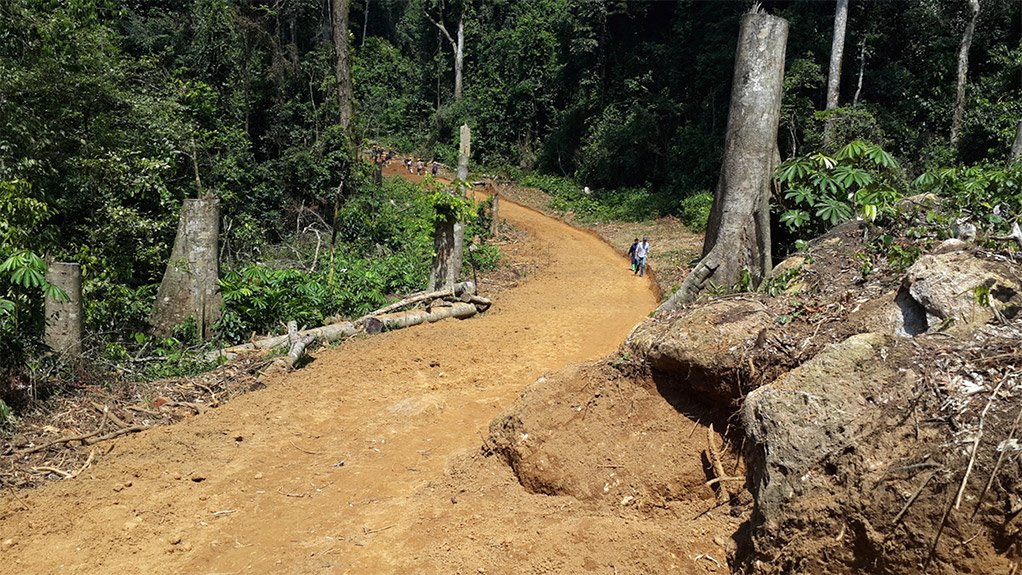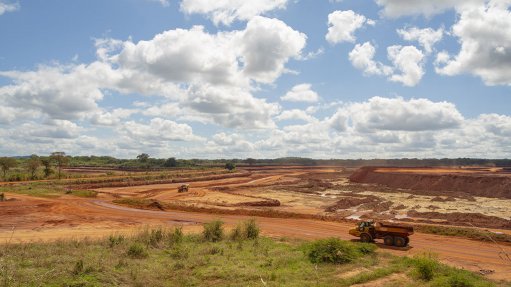IDC releases $7m for Congolese tin project, feasibility study results imminent



BISIE CAMP Alphamin will issue a definitive feasibility study for Bisie by the end of the first quarter
ACCESS ROAD CONSTRUCTION Alphamin is constructing a 30-km-long road to link Bisie to the main transport roads to provide improved access to and from the site
TSX-V-listed mineral exploration company Alphamin Resources has received the first two tranches from South African State-owned development finance institution the Industrial Development Corporation’s (IDC’s) $10-million exploration and development funding for its Bisie tin project, in the Democratic Republic of Congo (DRC).
Alphamin has received $4-million and $3-million from the IDC to date, while the final $3-million will be released subject to an independent peer review sign-off of a definitive feasibility study (DFS), which the company expects to receive in the second quarter of 2016.
The company has, since December 2013, also received $24-million in financing from Tremont Master Holdings, which owns a 44% stake in Alphamin. Tremont is a Mauritius-domiciled investment holding company funded by global private-equity firm Denham Capital.
Bisie consists of the Mpama North and Mpama South properties, in the Walikale district, about 180 km west-north-west of the regional centre of Goma, in the North Kivu province.
Alphamin CEO Boris Kamstra tells Mining Weekly that the company expects to issue a DFS for the project by the end of the first quarter 2016.
He notes that, since drilling started at the project site in July 2012, the company has drilled 207 holes for 36 820 m at Mpama North and 19 holes for 3 364 m at Mpama South.
The initial focus was at Mpama North, with an indicated mineral resource of 3.9-million tons at 3.94% tin for 155 300 t of contained tin at a cutoff grade of 0.5%, and an inferred mineral resource of 0.8-million tons at 4.6% tin for 38 900 t of contained tin at a cutoff grade of 0.5%. The indicated mineral resource represents a 30% increase in the estimate for that category first announced by Alphamin in March 2015.
The company will start the development of Bisie at Mpama North, with further exploration to be undertaken on Mpama South.
“Subject to the successful completion of our DFS, we aim to start construction of Bisie in early 2017, once we have completed fundraising for the project during 2016. Alphamin will then aim to have Bisie in operation by late 2018,” states Kamstra.
It is planned to be an underground operation with a gravity separation plant that will process the cassiterite material extracted from the mine to a tin concentrate.
The development and eventual operation of Bisie is expected to create about 500 job opportunities for Walikale locals. Alphamin is constructing a 30-km-long road to link Bisie to the main transport roads to provide improved access to and from the site, with the site currently employing about 200 locals, he explains. The first 5 km has been completed.
Kamstra acknowledges that operating in the DRC is not without challenges, particularly owing to the political, cultural and social climate that can prove “unpredictable and uncertain”, particularly when compounded by commodity price fluctuations.
However, he says the development and operation of Bisie have the potential to be a “catalytic economic event” for the North Kivu province, as it will show other companies that it is possible to develop a functional large-scale operation in the region and contribute to its stability and development.
“We have an experienced team heading up the Bisie projects, who also have experience in working in the DRC, including, but not limited to, chairperson Charles Needham, COO Trevor Faber, CFO Eoin O’Driscoll, Alphamin DRC MD Richard Robinson and myself,” Kamstra states.
He adds that the project has received an “overwhelmingly positive” response from local communities, local business and regional and political leaders, as well as foreign diplomats, who have recognised the importance of Bisie succeeding.
Kamstra highlights that, since 2006 and the introduction of legislation worldwide banning the use of lead in solder, particularly in water and electronic applications, tin has been the primary substitute.
This has resulted in a significant global uptick in demand, with the tin price increasing from about $10 000/t in 2004 to a high of $33000/t in April 2011. As of February 3, 2016, it sold for about $15 000/t.
Comments
Press Office
Announcements
What's On
Subscribe to improve your user experience...
Option 1 (equivalent of R125 a month):
Receive a weekly copy of Creamer Media's Engineering News & Mining Weekly magazine
(print copy for those in South Africa and e-magazine for those outside of South Africa)
Receive daily email newsletters
Access to full search results
Access archive of magazine back copies
Access to Projects in Progress
Access to ONE Research Report of your choice in PDF format
Option 2 (equivalent of R375 a month):
All benefits from Option 1
PLUS
Access to Creamer Media's Research Channel Africa for ALL Research Reports, in PDF format, on various industrial and mining sectors
including Electricity; Water; Energy Transition; Hydrogen; Roads, Rail and Ports; Coal; Gold; Platinum; Battery Metals; etc.
Already a subscriber?
Forgotten your password?
Receive weekly copy of Creamer Media's Engineering News & Mining Weekly magazine (print copy for those in South Africa and e-magazine for those outside of South Africa)
➕
Recieve daily email newsletters
➕
Access to full search results
➕
Access archive of magazine back copies
➕
Access to Projects in Progress
➕
Access to ONE Research Report of your choice in PDF format
RESEARCH CHANNEL AFRICA
R4500 (equivalent of R375 a month)
SUBSCRIBEAll benefits from Option 1
➕
Access to Creamer Media's Research Channel Africa for ALL Research Reports on various industrial and mining sectors, in PDF format, including on:
Electricity
➕
Water
➕
Energy Transition
➕
Hydrogen
➕
Roads, Rail and Ports
➕
Coal
➕
Gold
➕
Platinum
➕
Battery Metals
➕
etc.
Receive all benefits from Option 1 or Option 2 delivered to numerous people at your company
➕
Multiple User names and Passwords for simultaneous log-ins
➕
Intranet integration access to all in your organisation




















